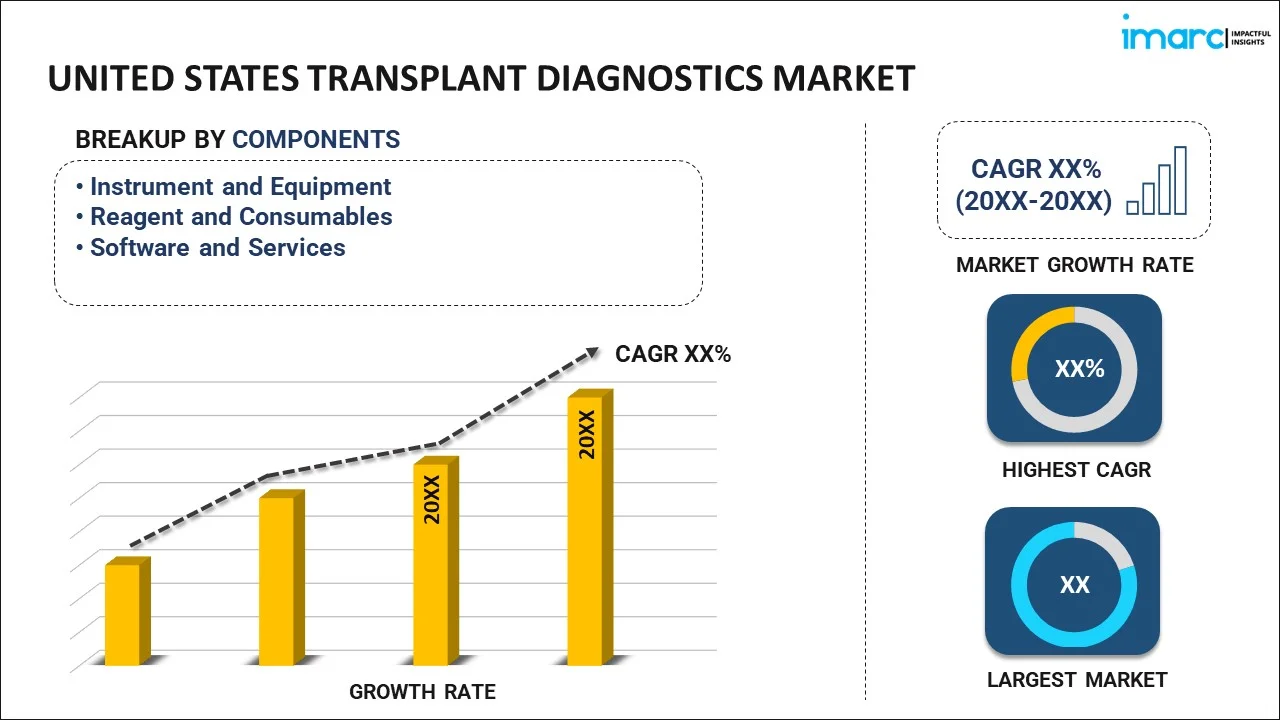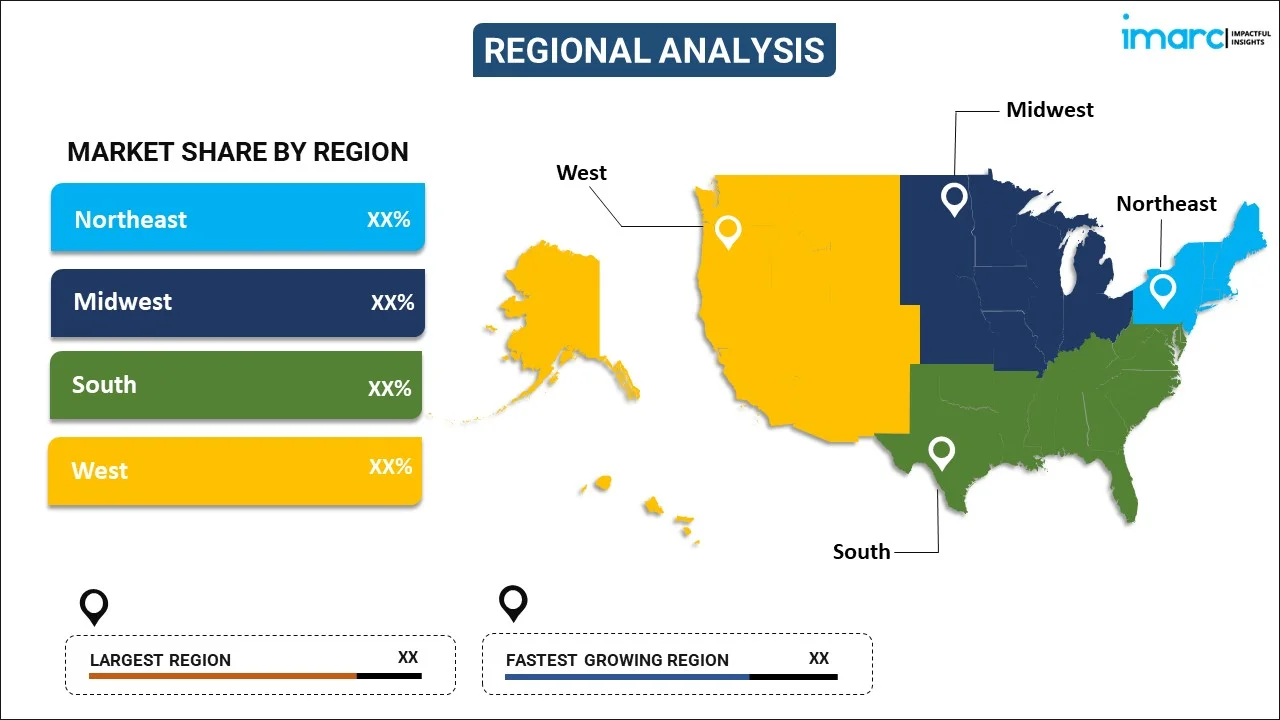
United States Transplant Diagnostics Market Report by Component (Instrument and Equipment, Reagent and Consumables, Software and Services), Technology (Non-Molecular Assay, Molecular Assay), Organ Type (Kidney, Liver, Heart, Lung, Pancreas, and Others), Application (Pre-Transplant Diagnostics, Post-Transplant Diagnostics), End User (Hospitals and Transplant Centers, Research Laboratories and Academic Institutes, Commercial Service Providers), and Region 2024-2032
Market Overview:
United States transplant diagnostics market size is projected to exhibit a growth rate (CAGR) of 7.64% during 2024-2032. The ongoing advancements in transplantation technologies, including precision medicine and personalized immunosuppression regimens, which contribute to the demand for sophisticated diagnostic tools, are driving the market.
|
Report Attribute
|
Key Statistics
|
|---|---|
|
Base Year
|
2023 |
|
Forecast Years
|
2024-2032
|
|
Historical Years
|
2018-2023
|
| Market Growth Rate (2024-2032) | 7.64% |
Transplant diagnostics involves a set of advanced techniques and tests aimed at assessing compatibility between organ donors and recipients during transplantation procedures. These diagnostics play a crucial role in minimizing the risk of rejection and improving overall transplant outcomes. Key components of transplant diagnostics include tissue typing, which analyzes human leukocyte antigens (HLAs) to match donors and recipients more accurately, and crossmatching, which detects pre-existing antibodies that might cause rejection. Additionally, molecular techniques like polymerase chain reaction (PCR) are utilized to refine donor-recipient matching. Transplant diagnostics enhance the precision of organ and tissue transplantation, helping clinicians make informed decisions and personalize treatment plans for patients undergoing these life-saving procedures. This field continues to evolve, contributing to advancements in transplant medicine and the overall success of transplantations.
United States Transplant Diagnostics Market Trends:
The transplant diagnostics market in the United States is experiencing robust growth, primarily propelled by increasing demand for organ transplantation procedures. Moreover, the rising prevalence of chronic diseases leading to organ failures has heightened the need for accurate and timely diagnostic solutions. Additionally, advancements in technology and molecular biology have played a pivotal role in enhancing the precision and efficiency of transplant diagnostics, fostering market expansion. Furthermore, the growing awareness regarding the benefits of personalized medicine and the imperative role of diagnostics in improving transplant outcomes has spurred investments in this sector. In tandem, supportive government initiatives and policies aimed at promoting organ donation and transplantation have created a conducive environment for market growth. Furthermore, collaborations between healthcare organizations, research institutions, and diagnostic companies have facilitated the development of innovative diagnostic tools and solutions, further driving market dynamics. The surge in R&D activities focusing on novel biomarkers and diagnostic techniques has also fueled the transplant diagnostics market. In essence, a confluence of factors, including technological advancements, increased disease prevalence, and collaborative efforts within the healthcare ecosystem, are acting as synergistic drivers, propelling the transplant diagnostics market forward in the United States.
United States Transplant Diagnostics Market Segmentation:
IMARC Group provides an analysis of the key trends in each segment of the market, along with forecasts at the country level for 2024-2032. Our report has categorized the market based on component, technology, organ type, application, and end user.
Component Insights:

- Instrument and Equipment
- Reagent and Consumables
- Software and Services
The report has provided a detailed breakup and analysis of the market based on the component. This includes instrument and equipment, reagent and consumables, and software and services.
Technology Insights:
- Non-Molecular Assay
- Serological Assay
- Mixed Lymphocyte Culture
- Molecular Assay
- PC-based
- Sequencing-based
A detailed breakup and analysis of the market based on the technology have also been provided in the report. This includes non-molecular assay (serological assay and mixed lymphocyte culture) and molecular assay (PC-based and sequencing-based).
Organ Type Insights:
- Kidney
- Liver
- Heart
- Lung
- Pancreas
- Others
The report has provided a detailed breakup and analysis of the market based on the organ type. This includes kidney, liver, heart, lung, pancreas, and others.
Application Insights:
- Pre-Transplant Diagnostics
- Post-Transplant Diagnostics
A detailed breakup and analysis of the market based on the application have also been provided in the report. This includes pre-transplant diagnostics and post-transplant diagnostics.
End User Insights:
- Hospitals and Transplant Centers
- Research Laboratories and Academic Institutes
- Commercial Service Providers
The report has provided a detailed breakup and analysis of the market based on the end user. This includes hospitals and transplant centers, research laboratories and academic institutes, and commercial service providers.
Regional Insights:

- Northeast
- Midwest
- South
- West
The report has also provided a comprehensive analysis of all the major regional markets, which include Northeast, Midwest, South, and West.
Competitive Landscape:
The market research report has also provided a comprehensive analysis of the competitive landscape in the market. Competitive analysis such as market structure, key player positioning, top winning strategies, competitive dashboard, and company evaluation quadrant has been covered in the report. Also, detailed profiles of all major companies have been provided.
United States Transplant Diagnostics Market Report Coverage:
| Report Features | Details |
|---|---|
| Base Year of the Analysis | 2023 |
| Historical Period | 2018-2023 |
| Forecast Period | 2024-2032 |
| Units | US$ Million |
| Scope of the Report | Exploration of Historical and Forecast Trends, Industry Catalysts and Challenges, Segment-Wise Historical and Predictive Market Assessment:
|
| Components Covered | Instrument and Equipment, Reagent and Consumables, Software and Services |
| Technologies Covered |
|
| Organ Types Covered | Kidney, Liver, Heart, Lung, Pancreas, Others |
| Applications Covered | Pre-Transplant Diagnostics, Post-Transplant Diagnostics |
| End Users Covered | Hospitals and Transplant Centers, Research Laboratories and Academic Institutes, Commercial Service Providers |
| Regions Covered | Northeast, Midwest, South, West |
| Customization Scope | 10% Free Customization |
| Report Price and Purchase Option | Single User License: US$ 3699 Five User License: US$ 4699 Corporate License: US$ 5699 |
| Post-Sale Analyst Support | 10-12 Weeks |
| Delivery Format | PDF and Excel through Email (We can also provide the editable version of the report in PPT/Word format on special request) |
Key Questions Answered in This Report:
- How has the United States transplant diagnostics market performed so far and how will it perform in the coming years?
- What has been the impact of COVID-19 on the United States transplant diagnostics market?
- What is the breakup of the United States transplant diagnostics market on the basis of component?
- What is the breakup of the United States transplant diagnostics market on the basis of technology?
- What is the breakup of the United States transplant diagnostics market on the basis of organ type?
- What is the breakup of the United States transplant diagnostics market on the basis of application?
- What is the breakup of the United States transplant diagnostics market on the basis of end user?
- What are the various stages in the value chain of the United States transplant diagnostics market?
- What are the key driving factors and challenges in the United States transplant diagnostics?
- What is the structure of the United States transplant diagnostics market and who are the key players?
- What is the degree of competition in the United States transplant diagnostics market?
Key Benefits for Stakeholders:
- IMARC’s industry report offers a comprehensive quantitative analysis of various market segments, historical and current market trends, market forecasts, and dynamics of the United States transplant diagnostics market from 2018-2032.
- The research report provides the latest information on the market drivers, challenges, and opportunities in the United States transplant diagnostics market.
- Porter's five forces analysis assist stakeholders in assessing the impact of new entrants, competitive rivalry, supplier power, buyer power, and the threat of substitution. It helps stakeholders to analyze the level of competition within the United States transplant diagnostics industry and its attractiveness.
- Competitive landscape allows stakeholders to understand their competitive environment and provides an insight into the current positions of key players in the market.
Need more help?
- Speak to our experienced analysts for insights on the current market scenarios.
- Include additional segments and countries to customize the report as per your requirement.
- Gain an unparalleled competitive advantage in your domain by understanding how to utilize the report and positively impacting your operations and revenue.
- For further assistance, please connect with our analysts.
 Inquire Before Buying
Inquire Before Buying
 Speak to an Analyst
Speak to an Analyst
 Request Brochure
Request Brochure
 Request Customization
Request Customization




.webp)




.webp)












